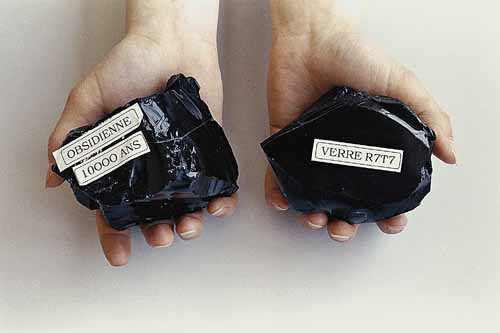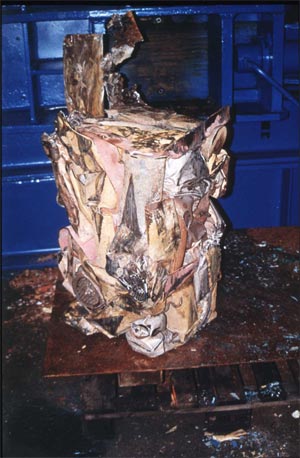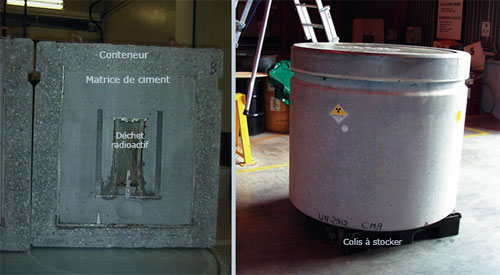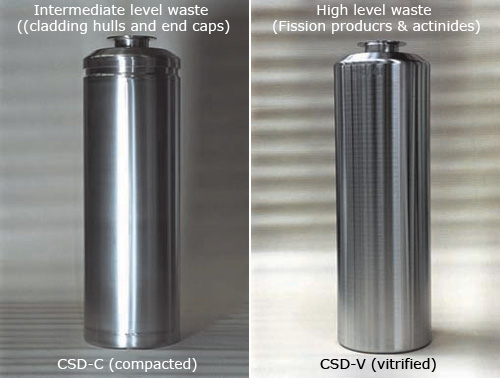Immobilising radioactivity

Natural glass and glass for waste
The durability of naturally-occurring glass provides a guide of such materials over very long periods. Volcanic obsidian can be compared with a sample of R7T7 glass, which is used for waste. (the sample being held in the photo has not been filled with radioactive atoms !). Experts estimate the life of such glass to be more than 10,000 years, after which time the initial radioactivity will have decayed by a factor of more than 1,000.
© CEA-FOULON
A highly effective technique for protecting against radiation from radioactive bodies is to concentrate and then condition them in an inert form that prevents them from migrating into the environment, particularly as a result of action by water. Waste is placed inside containers to form solid, stable packages that are easy to handle and transport, ready for interim storage or permanent disposal.
A variety of media are used to trap radioactive atoms, including cement, bitumen, thermoset resins, glass and ceramics. Together with the container, the resulting « containment matrix » in which the radioactive elements are embedded forms a protection barrier. The choice of medium depends on the radioactivity in the waste. Considering the very long term, a repository in a geological medium will perform the containment role, when the container and containment matrix have disappeared or been degraded.

Waste compaction
Very low-level metallic waste is compacted to facilitate conditioning and disposal. Low-level waste tends to be voluminous. As this type of waste contains little radioactive material, there is every reason to compact it.
© ANDRA
In France, glass is used for high-level waste resulting from reprocessing activities. This waste is vitrified (at the reprocessing plant in La Hague) in the form of borosilicate glass, which is highly resistant to both heat and radiation. This glass is then encased within a steel container that facilitates handling. The vitreous structure is highly resistant to contact with ground water. In the event of significant leaching, it may slowly be damaged by lixiviation.
The potential for embedding waste in ceramics is being researched, due to the exceptional water resistance of such materials, but ceramics are currently still costly to produce.
Intermediate-level long-lived waste (ILW-LL), which is produced in greater volumes than high-level waste (HLW), was until recently embedded in an inert material such as bitumen or concrete. Since 2002, this category of waste is compacted and placed inside a stainless steel container similar to those used for vitrified waste.

Cross-section of a cement-bound waste package
This cross-section of a cemented waste package illustrates one of the principles for conditioning, namely using a matrix to immobilise radioactive materials. A radioactive object is embedded in cement and then placed inside a container. Despite its simplicity, a cement matrix solution is adequate for low-level, short-lived radioactive waste. For intermediate- and high-level, long-lived waste, much more durable matrices must be used.
© ANDRA
Low-level radwaste contains little radioactive material. There are benefits in compacting it to reduce its volume. This category of waste is cast in cement, bitumen or resins enabling it to be placed in drums.
Plutonium recovered during reprocessing operations is conditioned as insoluble oxide (PuO2) in sealed boxes pending reuse in MOX fuel. The boxes are small to prevent any risk of criticality.

Compacted and vitrified waste containers
Intermediate-level (cladding hulls and end caps) and high-level (fission products and minor actinides) reprocessing waste is currently conditioned in containers that share very similar characteristics. Intermediate-level waste is compacted (in standard compacted waste containers – CSD-C) and high-level waste is embedded in a glass matrix (in standard vitreous waste containers – CSD-V).
© AREVA
Completing the list, some highly radioactive spent fuels unloaded from reactors remain to be conditioned. These non-reprocessed irradiated fuel assemblies are currently stored in pools or silos. These delicate, highly radioactive structures measuring more than 4m in length are cumbersome. When the time comes to dispose of them, they will be inserted into large, heavy transport containers, as in the USA and Sweden.
Articles on the subject « Waste Conditioning »
Vitrified High Level Waste
Glass – A very resistant matrix for high-level waste After the uranium and plutonium have b[...]
Resistance of R7T7 glass
Assessing the resistance of vitrified waste over millennia Is nuclear power a clean industry? To [...]
Conditioning Spent Fuel
Underground disposal of spent fuel – A long-term option Spent fuel assemblies unloaded from react[...]
Packaging Intermediate-level waste
Compaction for hulls and end caps… The zirconium alloy cladding around the uranium oxide pellets [...]
Low and very low level waste
Basic conditioning for low-level and very low-level waste Waste in which the radioactivity is low[...]
Radioactive Waste Containers
Canisters and containers for various types of waste France’s National Evaluation Commission[...]